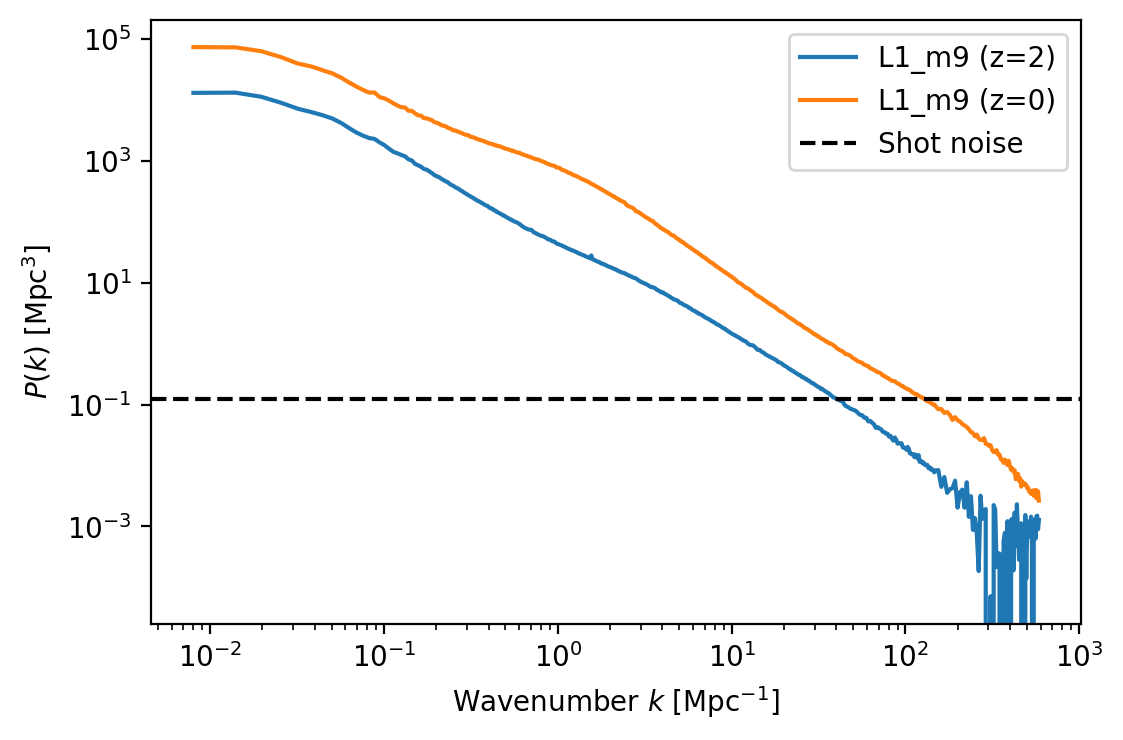Power Spectra
Matter Power Spectra
The total matter power spectra (calculated using all particle types, including neutrinos) can be downloaded for all simulations from https://ftp.strw.leidenuniv.nl/FLAMINGO/power_spectra/. The data from each simulation is contained within an HDF5 file. Each file contains the power spectra for 123 different redshifts. For each redshift we store the wavenumber, k, and the corresponding shot-noise subtracted power, P(k). The wavenumber has units of comoving Mpc-1 (note there is no factor of h), and the power has units of comoving Mpc3. The shot noise is stored as an attribute for each redshift, and also has units of comoving Mpc3. The following is an example python script for loading and plotting the power spectra for the L1_m9 simulation:
import h5py
import matplotlib.pyplot as plt
import numpy as np
fig, ax = plt.subplots(1)
with h5py.File('L1_m9.hdf5') as file:
for z in [2, 0]:
k = file[f'z={z:.2f}/k'][:]
p = file[f'z={z:.2f}/P(k)'][:]
ax.plot(k, p, label=f'L1_m9 (z={z})')
shot_noise = file['z=0.00'].attrs['Shot noise (Mpc**3)']
ax.axhline(shot_noise, c='k', ls='--', label='Shot noise')
ax.set_xlabel('Wavenumber $k$ [$\mathrm{Mpc}^{-1}$]')
ax.set_ylabel('$P(k)$ [$\mathrm{Mpc}^{3}$]')
ax.set_xscale('log')
ax.set_yscale('log')
ax.legend()

A description of each run, including cosmological parameters, can be found on the simulations page. To find the dark matter only equivalent of a hydrodynamical simulation, look for the run in the list of dark matter only simulations which has the same cosmology, box size, and number of particles. The power spectra do contain some small artifacts (such as the small peak in the middle of the z=2 line in the example) which are due to combining foldings, and are not real.
If you use the power spectra in a publication, then please cite the FLAMINGO project description paper (Schaye+23) and the paper presenting the power spectra (Schaller+24). If the calibration of the subgrid feedback is mentioned, then please cite the paper describing how the calibration was done (Kugel+23).
Baryonic response emulator
A Gaussian process emulator to model the effect of baryons on the matter power spectrum for all the simulations varying feedback in the FLAMINGO suite has been developed as part of Schaller+24. Upon acceptance of the paper it shall become publically available via PyPI index and on github.
The emulator can be used to predict the deviation of the matter power spectrum for the hydrodynamical simulation from the corresponding dark matter only simulation due to baryon and galaxy formation physics. The response as a function of wavenumber k is returned by the emulator as a function of redshift and three parameters characterizing the galaxy and cluster properties in the simulations. These are (i) the offset in the gas fraction in clusters from the Xray-based data used for the calibration of the simulations, (ii) the offset in the galaxy masses from the stellar mass function data used for the calibration, and (iii) the fraction of the AGN feedback taking place in the form of collimated jets as opposed to thermally-driven winds. The emulator is accurate to better than 1% for redshifts lower than 2 and for comoving scales up to k=10h/Mpc. Evaluation of the response for a given model is fast (1ms on 1 CPU core).